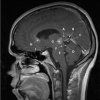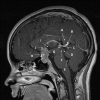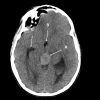Diagnosis and Management of Pineal Germinoma: From Eye to Brain
- PMID: 37077304
- PMCID: PMC10108908
- DOI: 10.2147/EB.S389631
Diagnosis and Management of Pineal Germinoma: From Eye to Brain
Abstract
Pineal germinomas can be very complex in terms of presentation, diagnosis, and management. This review attempts to simplify this complexity in an organized manner, addressing the anatomic relationships that provide the basis for the uniqueness of pineal germinoma. Ocular findings and signs and symptoms of elevated intracranial pressure are the keys to suspecting the diagnosis and obtaining the necessary imaging and cerebrospinal fluid studies. Other symptoms can suggest spread beyond the pineal region. Surgery may only be needed to obtain tissue for a definitive diagnosis, as germinoma is highly responsive to chemotherapy and focused radiation therapy. Hydrocephalus, usually related to tumor obstruction of the cerebral aqueduct, may also need to be addressed. Outcome for pineal germinoma is usually excellent, but relapse can occur and may require additional intervention. These issues are detailed in this review.
Keywords: anatomy; management; ocular findings; pineal germinoma; signs and symptoms.
© 2023 Cohen and Litofsky.
Conflict of interest statement
The authors report no conflicts of interest in this work.
Figures





Similar articles
-
Pure pineal germinomas: analysis of gender incidence.Acta Neurochir (Wien). 2006 Aug;148(8):865-71; discussion 871. doi: 10.1007/s00701-006-0846-x. Epub 2006 Jun 23. Acta Neurochir (Wien). 2006. PMID: 16791430
-
Fast-developing fatal diffuse leptomeningeal dissemination of a pineal germinoma in a young child: a case report and literature review.Br J Neurosurg. 2022 Apr;36(2):262-269. doi: 10.1080/02688697.2018.1520804. Epub 2018 Nov 19. Br J Neurosurg. 2022. PMID: 30451003 Review.
-
Neoadjuvant Chemotherapy Approach to Pineal Germinoma: A Case Report.Cureus. 2024 Jan 31;16(1):e53325. doi: 10.7759/cureus.53325. eCollection 2024 Jan. Cureus. 2024. PMID: 38435909 Free PMC article.
-
[Neuro-ophthalmological symptoms in patients with pineal and suprasellar germinoma].Vestn Oftalmol. 2020;136(4):39-46. doi: 10.17116/oftalma202013604139. Vestn Oftalmol. 2020. PMID: 32779455 Russian.
-
Pineal germ cell tumors: review.Klin Onkol. 2013;26(1):19-24. doi: 10.14735/amko201319. Klin Onkol. 2013. PMID: 23528168 Review.
Cited by
-
Diffuse peritoneal dissemination of intracranial pure germinoma via ventriculoperitoneal shunt.Neuroradiology. 2024 Oct;66(10):1705-1708. doi: 10.1007/s00234-024-03409-9. Epub 2024 Jun 19. Neuroradiology. 2024. PMID: 38896237 Free PMC article.
-
A Unique Case of Intracranial Bifocal Germinoma.Cureus. 2024 Jun 11;16(6):e62167. doi: 10.7759/cureus.62167. eCollection 2024 Jun. Cureus. 2024. PMID: 38993426 Free PMC article.
-
A rare case of pineal astrocytoma with hemorrhagic changes: Diagnostic and surgical challenges.Radiol Case Rep. 2025 Apr 10;20(6):3153-3158. doi: 10.1016/j.radcr.2025.03.003. eCollection 2025 Jun. Radiol Case Rep. 2025. PMID: 40247959 Free PMC article.
References
Publication types
LinkOut - more resources
Full Text Sources

